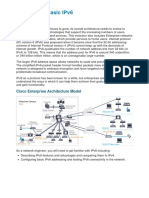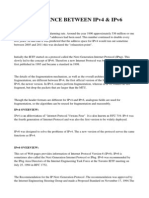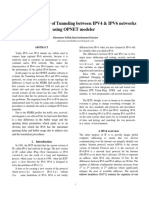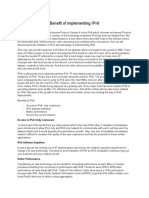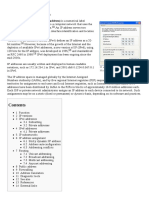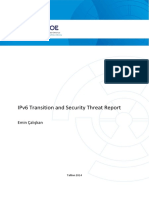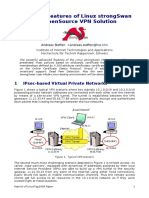E1-E2 - Text - Chapter 4. IPV6
E1-E2 - Text - Chapter 4. IPV6
Uploaded by
abhimirachi7077Copyright:
Available Formats
E1-E2 - Text - Chapter 4. IPV6
E1-E2 - Text - Chapter 4. IPV6
Uploaded by
abhimirachi7077Original Description:
Original Title
Copyright
Available Formats
Share this document
Did you find this document useful?
Is this content inappropriate?
Copyright:
Available Formats
E1-E2 - Text - Chapter 4. IPV6
E1-E2 - Text - Chapter 4. IPV6
Uploaded by
abhimirachi7077Copyright:
Available Formats
E1-E2 CFA IPv6
4 IPV6
4.1 LEARNING OBJECTIVES
Limitations Of IPv4
IPv6 Address Presentation
Features Of IPv6
IPv6 Header Format
IPv6 Prefixes & Types
The IPv6 Interface Id And Eui-64 Format
The IPv6 Address Hierarchy
Multicast Ipv6 Address
4.1 INTRODUCTION
Internet Protocol version 6 (IPv6) is the sixth revision in the development of the
Internet Protocol (IP) and the second version of the protocol to be widely deployed.
Together with IPv4, it is at the core of standards-based internetworking methods of the
Internet.
The current version of IP - IPv4 has not changed substantially since RFC 791,
which was published in 1981. IPv4 has proven to be robust, easily implemented, and
interoperable. It has stood up to the test of scaling an internetwork to a global utility the
size of today‘s Internet. This is a tribute to its initial design.
However, the initial design of IPv4 did not anticipate the areas like growth of
internet, need for simpler configuration, security consideration, support for prioritized
and real-time delivery of data etc.
4.2 IPV4
Limitations of IPv4
Features of IPv6
Uses of IPv6
4.3 LIMITATIONS OF IPV4
4.3.1 Addressing Problem
Although the 32-bit address space of IPv4 allows for 4.38 billion addresses, previous
and current allocation practices limit the number of public IPv4 addresses to a few
E1-E2 CFA Version 3.0 April 2021 Page 47 of 271
For Restricted Circulation
E1-E2 CFA IPv6
hundred million. As a result, public IPv4 addresses have become relatively scarce,
forcing many users and some organizations to use a NAT (Network Address
Translation) to map a single public IPv4 address to multiple private IPv4 addresses.
Additionally, the rising prominence of Internet-connected devices and appliances
ensures that the public IPv4 address space will eventually be depleted.
4.3.2 Routing Crises
Initially, IPv4 addressing scheme was following classful addressing. However, with the
expansion of Internet and re-allocation of IPv4 address space, this classful addressing
form lost its original shape and transformed into classless addressing by opting for
options like subnetting and VLSM. This resulted in loss of aggregation of routes and
routing entries have increased tremendously resulting in routing crises for the router for
routing the traffic.
4.3.3 End To End Problem
As current IPv4 address space provides only a few hundred million public addresses,
which are insufficient for fulfilling the need of hosts in the Internet world. In order to
overcome this limitation, with the help of NAT, a single global address is being mapped
with private address space. Although NATs promote reuse of the private address space,
they violate the fundamental design principle of the original Internet that all nodes have
a unique, globally reachable address, preventing true end-to-end connectivity for all
types of networking applications.
4.3.4 Security
Private communication over a public medium such as the Internet requires
cryptographic services that protect the data being sent from being viewed or modified in
transit. Although a standard now exists for providing security for IPv4 packets (known
as Internet Protocol security, or IPsec), this standard is optional for IPv4 and additional
security solutions, some of which are proprietary, are prevalent.
4.3.5 Mobility
The problem of mobility for IPv4 was first addressed in a standards track specification,
RFC 2002, ―IP Mobility Support,‖ in 1996. But this mobility is limited in true sense.
4.3.6 Performance And Cost
The performance of IPv4 network will deteriorate if the infrastructure is not upgraded
with time to match the traffic requirement which is increasing with application as well
as user base along with routing entries because of increasing network complexity. This
also involves cost in terms of trained man-power to maintain it. Also it requires efforts
E1-E2 CFA Version 3.0 April 2021 Page 48 of 271
For Restricted Circulation
E1-E2 CFA IPv6
for configuring services like NAT which is mainly because of scarcity of IPv4
resources.
4.4 IPV6 ADDRESS PRESENTATION
4.4.1 Ipv6 Address In Binary Form:
0010000111011010000000001101001100000000000000000010111100111011
0000001010101010000000001111111111111110001010001001110001011010
4.4.2 Divided Into 8 Blocks Of 16 Bit
0010000111011010 0000000011010011 0000000000000000 0010111100111011
0000001010101010 0000000011111111 1111111000101000 1001110001011010
Each 16-bit block is converted to hexadecimal and separated with colons:
21DA : 00D3 : 0000 : 2F3B : 02AA : 00FF : FE28 : 9C5A
4.4.3 Suppression Of Zeros
Suppress leading zeros within each 16-bit block:
2000:1110 :1287 : 0003 : F7A9 : 00FF : FE14 : 7AD2
As 2000 :1110 :1287 : 3 : F7A9 : FF : FE14 : 7AD2
But trailing 0s cannot be removed as shown:
2000 : 1110 : 1287 : 3000 : F7A9 : FF00 : FE14 :7AD2
cannot be written as:
2000: 1110 : 1287 : 3 : F7A9 : FF : FE14 : 7AD2
4.4.4 Compression Of Zeros
All zeros in a 16 bit block can be represented by single zero
2345 : 0000 : 0000 : 0000 : 0000 : 1234 : 3458 : AC19
can be represented as :
2345 : 0 : 0 : 0 : 0 : 1234 : 3458 : C19
An Address having more than one zeros can be represented as double colon ::
( Double Colon )
2345 : 0 : 0 : 0 : 0 : 1234 : 3458 : C19
E1-E2 CFA Version 3.0 April 2021 Page 49 of 271
For Restricted Circulation
E1-E2 CFA IPv6
becomes 2345 :: 1234 : 3458 : C19
FF02 : 0 : 0 : 0 : 0 : 0 : 0 : 2 becomes FF02::2
0:0:0:0:0:0:0:1 becomes ::1
FF02 : 0 : 0 : 0 : 0 : 0 : 0 : 0 becomes FF02 ::
Double colon :: can be used only once in an address.
2001 : 0 : 0 : 0 : 1234 : 0 : 0 : C1C0
can be written as
2001 :: 1234 : 0 : 0 : C1C0
Or 2001 : 0 : 0 : 0 : 1234 :: C1C0
but not as 2001 :: 1234 :: C1C0
4.5 FEATURES OF IPV6
4.5.1 Large Address Space
IPv6 has 128-bit (16-byte) addresses. Although 128 bits can express over 3.4 × 1038
possible combinations, the large address space of IPv6 has been designed to allow for
multiple levels of subnetting and address allocation, from the Internet backbone to the
individual subnets within an organization.
Even with all of the addresses currently assigned for use by hosts, plenty of addresses
are available for future use. With a much larger number of available addresses, address-
conservation techniques, such as the deployment of NATs, are no longer necessary.
4.5.2 Global Reachability
With IPv4 NATs, there is a technical barrier for applications that rely on listening or
peer based connectivity because of the need for the communicating peers to discover
and advertise their public IPv4 addresses and ports.
With IPv6, NATs are no longer necessary to conserve public address space, and the
problems associated with mapping addresses and ports disappear for developers of
applications and gateways. More importantly, end-to-end communication is restored
between hosts on the Internet by using addresses in packets that do not change in
transit. This functional restoration has immense value when one considers the
emergence of peer-to-peer telephony, video, and other real-time collaboration
technologies for personal communications etc.
E1-E2 CFA Version 3.0 April 2021 Page 50 of 271
For Restricted Circulation
E1-E2 CFA IPv6
By restoring global addressing and end-to-end connectivity, IPv6 has no barrier to new
applications that are based on ad hoc connectivity and peer-based communication.
4.5.3 Scoped Address And Address Selection
Unlike IPv4 addresses, IPv6 addresses have a scope, or a defined area of the network
over which they are unique and relevant. For example, IPv6 has a global address that is
equivalent to the IPv4 public address and a unique local address that is roughly
equivalent to the IPv4 private address. Typical IPv4 routers do not distinguish a public
address from a private address and will forward a privately addressed packet on the
Internet. An IPv6 router, on the other hand, is aware of the scope of IPv6 addresses and
will never forward a packet over an interface that does not have the correct scope.
There are different types of IPv6 addresses with different scopes. When multiple IPv6
addresses are returned in a DNS name query, the sending node must be able to
distinguish their types and, when initiating communication, use a pair (source address
and destination address) that is matched in scope and that is the most appropriate pair to
use. For example, for a source and a destination that have been assigned both global
(public) and link-local addresses, a sending IPv6 host would never use a global
destination with a link-local source. IPv6 sending hosts include the address selection
logic that is needed to decide which pair of addresses to use in communication.
Moreover, the address selection rules are configurable.
This allows you to configure multiple addressing infrastructures within an organization.
Regardless of how many types of addressing infrastructures are in place, the sending
host always chooses the ―best‖ set of addresses. In comparison, IPv4 nodes have no
awareness of address types and can send traffic to a public address from a private
address.
The benefit of scoped addresses is that by using the set of addresses of the smallest
scope, your traffic does not travel beyond the scope for the address, exposing your
network traffic to fewer possible malicious hosts.
4.5.4 New Header Format
The IPv6 header has a new format that is designed to minimize header processing. This
is achieved by moving both nonessential and optional fields to extension headers that
are placed after the IPv6 header. The streamlined IPv6 header is more efficiently
processed at intermediate routers.
IPv4 headers and IPv6 headers are not interoperable. IPv6 is not a superset of
functionality that is backward compatible with IPv4.
E1-E2 CFA Version 3.0 April 2021 Page 51 of 271
For Restricted Circulation
E1-E2 CFA IPv6
Implementation of both IPv4 and IPv6 to recognize and process both header formats.
The new default IPv6 header is only twice the size of the default IPv4 header, even
though the number of bits in IPv6 addresses is four times larger than IPv4 addresses.
4.5.5 Stateless And Stateful Address Configuration
To simplify host configuration, IPv6 supports both stateful address configuration (such
as address configuration in the presence of a DHCP for IPv6) and stateless address
configuration (such as address configuration in the absence of a DHCPv6 server).
With stateless address configuration, hosts on a link automatically configure themselves
with IPv6 addresses for the link (called link-local addresses), with IPv6 transition
addresses, and with addresses derived from prefixes advertised by local routers.
4.5.6 Ipsec Header Support Required
Support for the IPsec headers is an IPv6 protocol suite requirement. This requirement
provides a standards-based solution for network protection needs and promotes
interoperability between different IPv6 implementations. IPsec consists of two types of
extension headers and a protocol to negotiate security settings. The Authentication
header (AH) provides data integrity, data authentication, and replay protection for the
entire IPv6 packet (excluding fields in the IPv6 header that must change in transit). The
Encapsulating Security Payload (ESP) header and trailer provide data integrity, data
authentication, data confidentiality, and replay protection for the ESP-encapsulated
payload.
4.5.7 Better Support For Prioritized Delivery
New fields in the IPv6 header define how traffic is handled and identified. Traffic is
prioritized using a Traffic Class field, which specifies a DSCP value just like IPv4. A
Flow Label field in the IPv6 header allows routers to identify and provide special
handling for packets that belong to a flow (a series of packets between a source and
destination). Because the traffic is identified in the IPv6 header, support for prioritized
delivery can be achieved even when the packet payload is encrypted with IPsec and
ESP.
4.5.8 New Protocol For Neighboring Node Interaction
The Neighbor Discovery protocol for IPv6 is a series of Internet Control Message
Protocol for IPv6 (ICMPv6) messages that manages the interaction of neighboring
nodes (nodes on the same link). Neighbor Discovery replaces and extends the Address
Resolution Protocol (ARP) (broadcast-based), ICMPv4 Router Discovery, and ICMPv4
Redirect messages with efficient multicast and unicast Neighbor Discovery messages.
4.5.9 Extensibility
E1-E2 CFA Version 3.0 April 2021 Page 52 of 271
For Restricted Circulation
E1-E2 CFA IPv6
IPv6 can easily be extended for new features by adding extension headers after the IPv6
header. Unlike options in the IPv4 header, which can support only 40 bytes of options,
the size of IPv6 extension headers is constrained only by the size of the IPv6 packet.
4.5.10 Efficient Forwarding
IPv6 is a streamlined version of IPv4. Excluding prioritized delivery traffic, IPv6 has
fewer fields to process and fewer decisions to make in forwarding an IPv6 packet.
Unlike IPv4, the IPv6 header is a fixed size (40 bytes), which allows routers to process
IPv6 packets faster.
Additionally, the hierarchical and summarizable addressing structure of IPv6 global
addresses means that there are fewer routes to analyze in the routing tables of
organization and Internet backbone routers. The consequence is traffic that can be
forwarded at higher data rates, resulting in higher perforance for tomorrow‘s high-
bandwidth applications that use multiple data types.
4.5.11 Support For Security And Mobility
IPv6 has been designed to support security (IPsec) (AH and ESP header support
required) and mobility (Mobile IPv6) (optional). Although one could argue that these
features are available for IPv4, they are available on IPv4 as extensions, and therefore
they have architectural or connectivity limitations that might not have been present if
they had been part of the original IPv4 design. It is always better to design features in
rather than bolt them on. The result of designing IPv6 with security and mobility in
mind is an implementation that is a defined standard, has fewer limitations, and is more
robust and scalable to handle the current and future communication needs of the users
of the Internet.
The business benefit of requiring support for IPsec and using a single, global address
space is that IPv6 can protect packets from end to end across the entire IPv6 Internet.
Unlike IPsec on the IPv4 Internet, which must be modified and has limited functionality
when the endpoints are behind NATs, IPsec on the IPv6 Internet is fully functional
between any two endpoints.
4.6 IPV6 HEADER FORMAT
The format of the IPv6 packet header is simplified from its counterpart in IPv4. The
length of the IPv6 header increases to 40 bytes (from 20 bytes) and contains two 16-
byte addresses (source and destination), preceded by 8 bytes of control information, as
shown in Figure.
E1-E2 CFA Version 3.0 April 2021 Page 53 of 271
For Restricted Circulation
E1-E2 CFA IPv6
Figure 24: Header format
The IPv4 header has two 4-byte addresses preceded by 12 bytes of control
information and possibly followed by option data. The reduction of the control
information and the elimination of options in the header for most IP packets
optimizes the processing time per packet in a router. The infrequently used fields
removed from the header are moved to optional extension headers when they are
required.
The IPv6 header has 8 fields and is 320 bits long. It has been considerably
streamlined compared to its IPv4 counterpart, which has 12 fields and is 160 bits
long.
Field Length Description
Version 4 bits Version of IP (in this case, IPv6)
Traffic Class 8 bits Classifies traffic for QoS
Flow Label 20 bits Identifies a flow between a source and
destination
Payload Length 16 bits Length of data in packet
E1-E2 CFA Version 3.0 April 2021 Page 54 of 271
For Restricted Circulation
E1-E2 CFA IPv6
Next Header 8 bits Specifies the next upper-layer or
extension header
Hop Limit 8 bits Decremented by each router traversed
Source Address 128 bits Source IPv6 address
Destination 128 bits Destination IPv6 address
Address
Table 2. IPv6 Headers
The Next Header field is of some importance. This field can identify either the next
upper-layer header (for example, UDP, TCP or ICMP), or it can identify a special
Extension Header, which is placed in between the IPv6 and upper layer header.
Several such extension headers exist, and are usually processed in the following order:
Hop-by-Hop Options – specifies options that should be processed by every router in
the path. Directly follows the IPv6 header.
Destination Options – specifies options that should be processed by the destination
device.
Routing Header – specifies each router the packet must traverse to reach the
destination (source routing)
Fragment Header – used when a packet is larger than the MTU for the path
Authentication Header – used to integrate IPSEC Authentication Header (AH) into the
IPv6 packet
ESP Header – used to integrate IPSEC Encapsulating Security Payload (ESP) into the
IPv6 packet
4.7 IPV6 PREFIXES & TYPES OF IPV6
Prefix is the part of the address where the bits have fixed values or are the bits of a route
or subnet identifier.
Prefixes for IPv6 subnet identifiers, routes, and address ranges are expressed in the
same way as Classless Inter-Domain Routing (CIDR) notation for IPv4.
An IPv6 prefix is written in address/prefix-length notation.
Examples:
21DA:D3::/48 for a route
E1-E2 CFA Version 3.0 April 2021 Page 55 of 271
For Restricted Circulation
E1-E2 CFA IPv6
21DA:D3:0:2F3B::/64 for a subnet
No more dotted decimal subnet masks
Typical unicast IPv6 address:
64 bits for subnet ID, 64 bits for interface ID
Full Address: 1254:1532:26B1:CC14:123:1111:2222:3333/64
Prefix ID: 1254:1532:26B1:CC14:
Host ID: 123:1111:2222:3333
The /64 indicates that the first 64 bits of this address identify the prefix.
4.8 THE IPV6 INTERFACE ID AND EUI-64 FORMAT
The host portion of an IPv4 address is not based on the hardware address of an
interface. IPv4 relies on Address Resolution Protocol (ARP) to map between the
logical IP address and the 48-bit hardware MAC address.
IPv6 unicasts generally allocate the first 64 bits of the address to identify the network
(prefix), and the last 64 bits to identify the host (referred to as the interface ID). The
interface ID is based on the interface‘s hardware address.
This interface ID adheres to the IEEE 64-bit Extended Unique Identifier (EUI-64)
format. Since most interfaces still use the 48-bit MAC address, the MAC must be
converted into the EUI-64 format.
Consider the following MAC address: 1111.2222.3333. The first 24 bits, the
Organizationally Unique Identifier (OUI), identify the manufacturer. The last 24 bits
uniquely identify the host. To convert this to EUI-64 format:
1. The first 24 bits of the MAC (the OUI), become the first 24
bits of the EUI-64 formatted interface ID.
2. The seventh bit of the OUI is changed from a ―0‖ to a ―1‖.
3. The next 16 bits of the interface ID are FFFE.
4. The last 24 bits of the MAC (the host ID), become the last 24
bits of the interface ID.
Thus, the MAC address 1111.2222.3333 in EUI-64 format would become
1311:22FF:FE22:3333, which becomes the interface ID.
E1-E2 CFA Version 3.0 April 2021 Page 56 of 271
For Restricted Circulation
E1-E2 CFA IPv6
4.9 THE IPV6 ADDRESS HIERARCHY
IPv4 separated its address space into specific classes. The class of an IPv4 address was
identified by the high-order bits of the first octet:
Class A - (00000001 – 01111111, or 1 - 127)
Class B - (10000000 – 10111111, or 128 - 191)
Class C - (11000000 – 11011111, or 192 - 223)
Class D - (11100000 – 11101111, or 224 - 239)
IPv6‘s addressing structure is far more scalable. Less than 20% of the IPv6 address
space has been designated for use, currently. The potential for growth is enormous.
The address space that has been allocated is organized into several types, determined by
the high-order bits of the first field:
Special Addresses – addresses begin 00xx:
Link Local – addresses begin FE8x:
Site Local – addresses begin FECx:
Aggregate Global – addresses begin 2xxx: or 3xxx:
Multicasts – addresses begin FFxx:
Anycasts
(Note: an ―x‖ indicates the value can be any hexadecimal number)
There are no broadcast addresses in IPv6. Thus, any IPv6 address that is not a
multicast is a unicast address.
Anycast addresses identify a group of interfaces on multiple hosts. Thus, multiple
hosts are configured with an identical address. Packets sent to an anycast address are
sent to the nearest (i.e., least amount of hops) host.
Anycasts are indistinguishable from any other IPv6 unicast address.
Practical applications of anycast addressing are a bit murky. One possible application
would be a server farm providing an identical service or function, in which case anycast
addressing would allow clients to connect to the nearest server.
4.10 SPECIAL (RESERVED) IPV6 ADDRESSES
The first field of a reserved or special IPv6 address will always begin 00xx.
Reserved addresses represent 1/256th of the available IPv6 address space. Various
reserved addresses exist, including:
0:0:0:0:0:0:0:0 (or ::) – is an unspecified or unknown address.
It is the equivalent of the IPv4 0.0.0.0 address, which indicates
E1-E2 CFA Version 3.0 April 2021 Page 57 of 271
For Restricted Circulation
E1-E2 CFA IPv6
the absence of a configured or assigned address. In routing tables,
the unspecified address is used to identify all or any possible
hosts or networks.
0:0:0:0:0:0:0:1 (or ::1) – is the loopback or localhost address.
It is the equivalent of the IPv4 127.0.0.1 address.
4.11 RESERVED ADDRESSES - IPV4 AND IPV6
COMPATIBILITY
To alleviate the difficulties of immediately migrating from IPv4 to IPv6, specific
reserved addresses can be used to embed an IPv4 address into an IPv6 address.
Two types of addresses can be used for IPv4 embedding, IPv4-compatible IPv6
addresses, and IPv4-mapped IPv6 addresses.
0:0:0:0:0:0:a.b.c.d (or ::a.b.c.d) – is an IPv4-compatible
IPv6 address. This address is used on devices that support
both IPv4 and IPv6. A prefix of /96 is used for IPv4-
compatible IPv6 addresses:
::192.168.1.1/96
0:0:0:0:0:FFFF:a.b.c.d (or ::FFFF:a.b.c.d) – is an IPv4-
mapped IPv6 address. This address is used by IPv6 routers
and devices to identify non-IPv6 capable devices. Again, a
prefix of /96 is used for IPv4-mapped IPv6 addresses:
::FFFF:192.168.1.1/96
4.12 LINK-LOCAL IPV6 ADDRESSES
Link-local IPv6 addresses are used only on a single link (subnet). Any packet that
contains a link-local source or destination address is never routed to another link. Every
IPv6-enabled interface on a host (or router) is assigned a link-local address. This
address can be manually assigned, or auto-configured.
The first field of a link-local IPv6 address will always begin FE8x (1111 1110 10).
Link-local addresses are unicasts, and represent 1/1024th of the available IPv6 address
space. A prefix of /10 is used for link-local addresses.
FE80::1311:22FF:FE22:3333/10
There is no hierarchy to a link-local address:
The first 10 bits are fixed (FE8), known as the Format Prefix (FP).
E1-E2 CFA Version 3.0 April 2021 Page 58 of 271
For Restricted Circulation
E1-E2 CFA IPv6
The next 54 bits are set to 0.
The final 64 bits are used as the interface ID.
4.13 SITE LOCAL IPV6 ADDRESSES
Site-local IPv6 addresses are the equivalent of ―private‖ IPv4 addresses. Site-local
addresses can be routed within a site or organization, but cannot be globally routed on
the Internet. Multiple private subnets within a ―site‖ are allowed.
The first field of a site-local IPv6 address will always begin FECx (1111 1110 11).
Site-local addresses are unicasts, and represent 1/1024th of the available IPv6 address
space.
FEC0::2731:E2FF:FE96:C283/64
Site-local addresses do adhere to a hierarchy:
The first 10 bits are the fixed FP (FEC).
The next 38 bits are set to 0.
The next 16 bits are used to identify the private subnet ID.
The final 64 bits are used as the
interface ID. To identify two separate
subnets (1111 and 2222):
FEC0::1111:2731:E2FF:FE96:C283/64
FEC0::2222:97A4:E2FF:FE1C:E2D1/64
4.14 AGGREGATE GLOBAL IPV6 ADDRESSES
Aggregate Global IPv6 addresses are the equivalent of ―public‖ IPv4 addresses.
Aggregate global addresses can be routed publicly on the Internet. Any device or site
that wishes to traverse the Internet must be uniquely identified with an aggregate global
address.
Currently, the first field of an aggregate global IPv6 address will always begin 2xxx
(001). Aggregate global addresses are unicasts, and represent 1/8th of the available IPv6
address space.
2001::2731:E2FF:FE96:C283/64
Aggregate global addresses adhere to a very strict hierarchy:
The first 3 bits are the fixed FP.
The next 13 bits are the top-level aggregation identifier (TLA ID).
The next 8 bits are reserved for future use.
E1-E2 CFA Version 3.0 April 2021 Page 59 of 271
For Restricted Circulation
E1-E2 CFA IPv6
The next 24 bits are the next-level aggregation identifier (NLA ID).
The next 16 bits are the site-level aggregation identifier (SLA ID).
The final 64 bits are used as the interface ID.
By have multiple levels, a consistent, organized, and scalable hierarchy is maintained.
High level registries are assigned ranges of TLA IDs. These can then be subdivided in
the NLA ID field, and passed on to lower-tiered ISPs.
Such ISPs allocate these prefixes to their customers, which can further subdivide the
prefix using the SLA ID field, to create whatever local hierarchy they wish. The 16-bit
SLA field provides up to 65535 networks for an organization.
Note: Do not confuse the SLA ID field of a global address field, with a site- local
address. Site-local addresses cannot be routed publicly, where as SLA ID‘s are just a
subset of the publicly routable aggregate global address.
4.15 MULTICAST IPV6 ADDRESSES
Multicast IPv6 addresses are the equivalent of IPv4 multicast addresses. Interfaces can
belong to one or more multicast groups. Interfaces will accept a multicast packet only if
they belong to that group. Multicasting provides a much more efficient mechanism than
broadcasting, which requires that every host on a link accept and process each
broadcast packet.
The first field of a multicast IPv6 address will always begin FFxx (1111 1111). The
full multicast range is FF00 through FFFF. Multicasts represent 1/256th of the
available IPv6 address space.
FF01:0:0:0:0:0:0:1
Multicast addresses follow a specific format:
The first 8 bits identify the address as a multicast (1111 1111)
The next 4 bits are a flag value. If the flag is set to all zeroes
(0000), the multicast address is considered well-known.
The next 4 bits are a scope value:
o 0000 (0) = Reserved
o 0001 (1) = Node Local Scope
o 0010 (2) = Link Local Scope
o 0101 (5) = Site Local Scope
o 1000 (8) = Organization Local Scope
o 1110 (e) = Global Scope
o 1111 (f) = Reserved
The final 112 bits identify the actual multicast group.
E1-E2 CFA Version 3.0 April 2021 Page 60 of 271
For Restricted Circulation
E1-E2 CFA IPv6
IPv4 multicast addresses had no mechanism to support multiple ―scopes.”
IPv6 scopes allow for a multicast hierarchy, a way to contain multicast
traffic.
4.16 COMMON IPV6 MULTICAST ADDRESSES
The following is a list of common, well-known IPv6 multicast addresses:
Node-Local Scope Multicast Addresses
FF01::1 – All-nodes address
FF01::2 – All-routers address
Link-Local Scope Multicast Addresses
FF02::1 – All-nodes address
FF02::2 – All-routers address
FF02::5 – OSPFv3 (OSPF IPv6) All SPF Routers
FF02::6 – OSPFv3 Designated Routers
FF02::9 – RIPng Routers
FF02::13 – PIM Routers
Site-Local Scope Multicast Addresses
FF05::2 – All-routers address
All hosts must join the all-nodes multicast group, for both the node-local and link-local
scopes. All routers must join the all-routers multicast group, for the node-local, link-
local, and site-local scopes.
Every site-local and aggregate global address is assigned a solicited-node multicast
address. This solicited-node address is created by appending the last 24 bits of the
interface ID to the following prefix: FF02::1:FF/103.
Thus, if you have a site-local address of:
FEC0::1111:2731:E2FF:FE96:C283
The corresponding solicited-node multicast address would be:
FF02::1:FF96:C283
Solicited-node multicast addresses are most often used for neighbor discovery (covered
in an upcoming section in this guide).
E1-E2 CFA Version 3.0 April 2021 Page 61 of 271
For Restricted Circulation
E1-E2 CFA IPv6
4.17 REQUIRED IPV6 ADDRESSES
At a minimum, each IPv6 interface on a host must recognize the following IPv6
addresses:
The loopback address
A link-local address
Any configured site-local or aggregate global addresses
Any configured multicast groups
The all-nodes multicast address (both node-local and
link-local scopes)
The solicited-node multicast address for any configured
unicast addresses
In addition to the above addresses, each IPv6 interface on a router must recognize the
following IPv6 addresses:
The subnet-router anycast address
Any configured multicast groups
The all-routers multicast address (node-local, link-local, and site-
local scopes)
4.18 CONCLUSION
There are many reasons for IPv6 supports and there is also need to migrate from
current version of Internet IPv4 to IPv6 for availing additional benefits of Internet.
However, for quite some time, things will move in parallel and smooth transition will
be in benefit for the Internet world. Therefore, we will see IPv4 and IPv6
simultaneously being used by the Internet users, and the service provider. Also the
application that will be developed during this phase will also keep in mind the
requirement of IPv4 and IPv6.
E1-E2 CFA Version 3.0 April 2021 Page 62 of 271
For Restricted Circulation
You might also like
- CCDE Practical Exam DumpsDocument9 pagesCCDE Practical Exam DumpsCCDE Lab DumpsNo ratings yet
- IPv6 Full Seminar ReportDocument35 pagesIPv6 Full Seminar ReportSumanth Matam80% (10)
- IPv6 FundamentalsDocument44 pagesIPv6 FundamentalsIvan Finek100% (1)
- Checkpoint VPN TroubleshootingDocument5 pagesCheckpoint VPN TroubleshootingSohel PathanNo ratings yet
- Mobile IPv6 SeminarDocument34 pagesMobile IPv6 SeminarTinsu M Babu100% (1)
- Name of Course: E1-E2 CFADocument20 pagesName of Course: E1-E2 CFArebba89No ratings yet
- 13 Introducing Basic IPv6Document43 pages13 Introducing Basic IPv6Lorenzo Maria MASELLINo ratings yet
- A Comparative Review of Internet ProtocoDocument4 pagesA Comparative Review of Internet Protocoeshunignitious23No ratings yet
- Ca2Document10 pagesCa2Souvik RockNo ratings yet
- Comparison Study Between IPV4 & IPV6: Amer Nizar Abu AliDocument4 pagesComparison Study Between IPV4 & IPV6: Amer Nizar Abu AliSuranga SampathNo ratings yet
- Difference Between IPv4 and IPv6Document5 pagesDifference Between IPv4 and IPv6Ardit Mezini100% (1)
- Comparison Between Ipv4 and Ipv6Document4 pagesComparison Between Ipv4 and Ipv6UgoStanNo ratings yet
- Group Assigment One FinalDocument9 pagesGroup Assigment One Finalnuredin abdellahNo ratings yet
- Audience: Why New IP Version?Document25 pagesAudience: Why New IP Version?Krishna PrasadNo ratings yet
- 3chapter IPv6Document19 pages3chapter IPv6VINAY TANWARNo ratings yet
- A Simulation Study of Tunneling Between IPV4 & IPV6 Networks Using OPNET ModelerDocument8 pagesA Simulation Study of Tunneling Between IPV4 & IPV6 Networks Using OPNET ModelerARTHURNo ratings yet
- Computer Network - Topic 8Document14 pagesComputer Network - Topic 8Dutchman CoolNo ratings yet
- IPV6 - Security and ImplementationDocument68 pagesIPV6 - Security and Implementationavijoshi4No ratings yet
- Address Resolution ProtocolDocument5 pagesAddress Resolution ProtocolTushar VermaNo ratings yet
- Ipv6 Primer CiscoDocument10 pagesIpv6 Primer CiscoDaniel RocaNo ratings yet
- AssignmentDocument7 pagesAssignmentranaatif0298No ratings yet
- Cisco Ipv6 ABCDocument76 pagesCisco Ipv6 ABCNelsonbohr100% (1)
- IPv4 Address Exhaustion - WikipediaDocument16 pagesIPv4 Address Exhaustion - WikipediaYessica Liliana Ruelas SotoNo ratings yet
- Ipv6 - Quick GuideDocument19 pagesIpv6 - Quick GuidejoseNo ratings yet
- Stage 3: Student Name Abdullah Hussein NassirDocument9 pagesStage 3: Student Name Abdullah Hussein Nassirالزهور لخدمات الانترنيتNo ratings yet
- IPv6 Full Seminar ReportDocument34 pagesIPv6 Full Seminar ReportPardeep Patel80% (5)
- Introduction To Ipv6: The Future of The InternetDocument8 pagesIntroduction To Ipv6: The Future of The InternetFană BogdanNo ratings yet
- IPv 6Document22 pagesIPv 6PK SNo ratings yet
- Deploying IPV6 Networks: Unit - 1Document14 pagesDeploying IPV6 Networks: Unit - 1Anonymous PDGLsjN1Q5No ratings yet
- Understanding Carrier Grade NATDocument23 pagesUnderstanding Carrier Grade NATSkdead SkdeadNo ratings yet
- Chapter 1: Ipv6: Note Vyatta Support For Ipv6 Has "Experimental" Status. Currently, Only Ipv6Document79 pagesChapter 1: Ipv6: Note Vyatta Support For Ipv6 Has "Experimental" Status. Currently, Only Ipv6Lee WiscovitchNo ratings yet
- IPv6 IPv4 PresentationDocument20 pagesIPv6 IPv4 PresentationShaheerNo ratings yet
- Title: Internet Protocol Version 6 Ipv6 1Document6 pagesTitle: Internet Protocol Version 6 Ipv6 1rahmatullah KhairiNo ratings yet
- A Comparative Review of IPv4 and IPv6 For Research Test Bed PDFDocument7 pagesA Comparative Review of IPv4 and IPv6 For Research Test Bed PDFjosephNo ratings yet
- Omnisecu IPv6Document23 pagesOmnisecu IPv6harmansagguNo ratings yet
- Benefit of Implementing Ipv6: Access To Ipv6-Only CustomersDocument5 pagesBenefit of Implementing Ipv6: Access To Ipv6-Only CustomersAbilashini jayakodyNo ratings yet
- IP Address: From Wikipedia, The Free EncyclopediaDocument9 pagesIP Address: From Wikipedia, The Free EncyclopediaAnonymous yDM6SRNo ratings yet
- ACN Chapter 2 - Part 1 Notes by Ur Engineering FriendDocument5 pagesACN Chapter 2 - Part 1 Notes by Ur Engineering Friend9B - 38Karan BhanushaliNo ratings yet
- IPv6 SlideDocument35 pagesIPv6 SlideChantich CharmtongNo ratings yet
- IPv6 Foundations v2016Document285 pagesIPv6 Foundations v2016ananthluckyNo ratings yet
- A Comparative Study On IPv4 and IPv6 PDFDocument9 pagesA Comparative Study On IPv4 and IPv6 PDFهمسه محمد بدرNo ratings yet
- A Comparative Study On Ipv4 and Ipv6: January 2015Document9 pagesA Comparative Study On Ipv4 and Ipv6: January 2015همسه محمد بدرNo ratings yet
- A Basic Introduction To IPv6Document1 pageA Basic Introduction To IPv6Fernanda AdhipramanaNo ratings yet
- TCP/IP Lab Manual BEDocument44 pagesTCP/IP Lab Manual BEChinmay Deshpande100% (1)
- Ch7. IPv6Document19 pagesCh7. IPv6Menow ShutterNo ratings yet
- Netcom Module IVDocument53 pagesNetcom Module IVMC JERID C. BATUNGBAKALNo ratings yet
- IPv6 PDFDocument155 pagesIPv6 PDFharikrishna242424No ratings yet
- Hari Krishna Raju Kanekal Nomus Comm-SystemsDocument155 pagesHari Krishna Raju Kanekal Nomus Comm-Systemsharikrishna242424No ratings yet
- Factsheet IPv6Document2 pagesFactsheet IPv6Daniel ChecchiaNo ratings yet
- CC 1Document11 pagesCC 1sanjayr232323No ratings yet
- Untuk Belajar IPv6Document5 pagesUntuk Belajar IPv6Fauzan Ardhika PutraNo ratings yet
- 01-09 Basic IPv6 Configuration PDFDocument49 pages01-09 Basic IPv6 Configuration PDFHamoud BourjNo ratings yet
- IPv6 ReportDocument11 pagesIPv6 ReportSridevi 20-403No ratings yet
- Advantages of Ipv6 in The Internet of ThingsDocument3 pagesAdvantages of Ipv6 in The Internet of Thingsrujula shindeNo ratings yet
- IP and SUbnetDocument20 pagesIP and SUbnetAlly MikoiNo ratings yet
- Unit 5 IPv6Document11 pagesUnit 5 IPv6Dudzayi KasiyoNo ratings yet
- Curs 4Document36 pagesCurs 4Zaha GeorgeNo ratings yet
- Project Black Hat3Document10 pagesProject Black Hat3Nawaraj KandelNo ratings yet
- Tugas 1 - IPv6 DatagramDocument19 pagesTugas 1 - IPv6 DatagramAdrianus AdnanNo ratings yet
- Ipv6 - The Next Generation ProtocolDocument22 pagesIpv6 - The Next Generation ProtocolCk JaanuNo ratings yet
- Internet TrafficsDocument2 pagesInternet TrafficsAndie GalangNo ratings yet
- E1-E2 - Text - Chapter 9. STAND-ALONE SIGNALING TRANSFER POINTDocument9 pagesE1-E2 - Text - Chapter 9. STAND-ALONE SIGNALING TRANSFER POINTabhimirachi7077No ratings yet
- E1-E2 - Text - Chapter 5. MPLS VPNDocument19 pagesE1-E2 - Text - Chapter 5. MPLS VPNabhimirachi7077No ratings yet
- E1-E2 - Text - Chapter 2. ROUTING PRINCIPLEDocument24 pagesE1-E2 - Text - Chapter 2. ROUTING PRINCIPLEabhimirachi7077No ratings yet
- E1-E2 - Text - Chapter 1. PACKET SWITCHINGDocument13 pagesE1-E2 - Text - Chapter 1. PACKET SWITCHINGabhimirachi7077No ratings yet
- Pan Os 81 Cli CommandsDocument488 pagesPan Os 81 Cli CommandsLocNo ratings yet
- HCIA Security V3.0 Converti - FormattedDocument58 pagesHCIA Security V3.0 Converti - Formattedomar omarNo ratings yet
- CSC342 - Network SecurityDocument3 pagesCSC342 - Network SecurityDilawarNo ratings yet
- Brkent 2653Document72 pagesBrkent 2653ymmkghNo ratings yet
- VPN Interoperability Between SonicWALL TELE3 SP and Netscreen ScreenOS 4x 5xDocument21 pagesVPN Interoperability Between SonicWALL TELE3 SP and Netscreen ScreenOS 4x 5xwandrelNo ratings yet
- Fortinet Product MatrixDocument4 pagesFortinet Product MatrixgenuinNo ratings yet
- 7100-Series Configuration Guide: Firmware Version 8.31Document800 pages7100-Series Configuration Guide: Firmware Version 8.31laurikapernasNo ratings yet
- En Security SBA Student Training Ans KeyDocument43 pagesEn Security SBA Student Training Ans Keybike0neNo ratings yet
- Ccna NotesDocument2 pagesCcna NotesAhmad AliNo ratings yet
- Pre - Modul B Integration Systems - Pre - It Network System - Lks Jabar 2021Document14 pagesPre - Modul B Integration Systems - Pre - It Network System - Lks Jabar 2021Smkplusysb SuryalayaNo ratings yet
- HN9600 Modem User GuideDocument36 pagesHN9600 Modem User GuidehamzaNo ratings yet
- Advanced Features of Linux Strongswan The Opensource VPN SolutionDocument17 pagesAdvanced Features of Linux Strongswan The Opensource VPN SolutionThinh LeNo ratings yet
- CCBC Network+ Quizlet PDFDocument24 pagesCCBC Network+ Quizlet PDFWENDELL MOYENo ratings yet
- Summary of Resolved Issues in BTS3900 V100R012C10SPC320 (eGBTS)Document82 pagesSummary of Resolved Issues in BTS3900 V100R012C10SPC320 (eGBTS)richardo simanullangNo ratings yet
- Cisco 892 Performance TestDocument39 pagesCisco 892 Performance TestYibrail Veliz PluaNo ratings yet
- Aruba IAP VPN Solution Guide For Teleworkers and Home OfficesDocument33 pagesAruba IAP VPN Solution Guide For Teleworkers and Home OfficesAndre SilvaNo ratings yet
- Using Policy-Based Ipsec VPN For Communication Between OfficesDocument7 pagesUsing Policy-Based Ipsec VPN For Communication Between OfficesNgọc Duy VõNo ratings yet
- Unit-5 - Network SecurityDocument97 pagesUnit-5 - Network Securityyototi8935No ratings yet
- Scell-Ef User ManualDocument80 pagesScell-Ef User ManualChristianNo ratings yet
- 10 WeekDocument31 pages10 WeekWisam Makki AlwashNo ratings yet
- 03ds One5g EkinopsDocument4 pages03ds One5g EkinopsBojan SubasicNo ratings yet
- AZ-104 458题Document487 pagesAZ-104 458题hyoitoNo ratings yet
- CNS Chapter 4Document17 pagesCNS Chapter 4Divya shreeNo ratings yet
- Bca Semester-Vi 2023-24Document4 pagesBca Semester-Vi 2023-24laserbolt2002No ratings yet
- 04 - CS1000 - SecurityDocument74 pages04 - CS1000 - Securityjose de la rivaNo ratings yet
- VPN Capability IPsec - PFSenseDocsDocument7 pagesVPN Capability IPsec - PFSenseDocsIsac Jr.No ratings yet
- PCNSC Dump 2023Document18 pagesPCNSC Dump 2023xbyg6xmdgsNo ratings yet
- Juniper SRX300 SeriesDocument110 pagesJuniper SRX300 SeriesoskgraficoNo ratings yet






